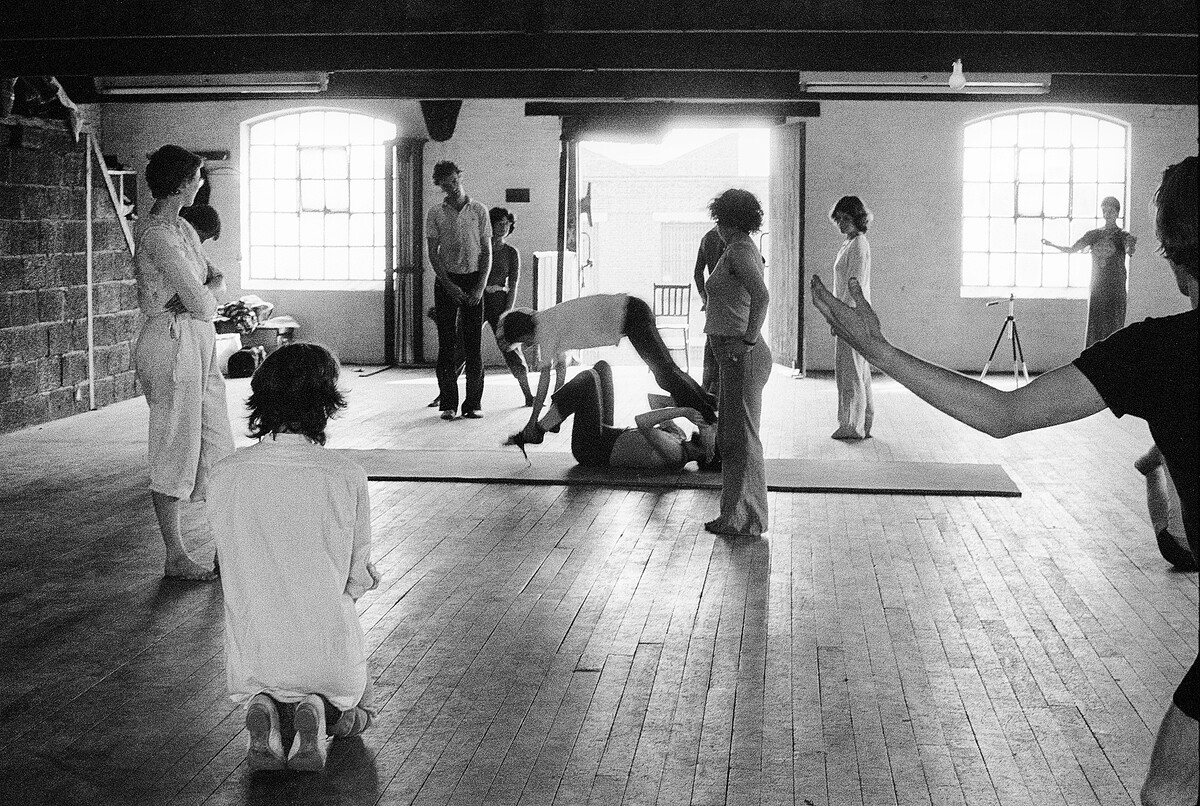February 7–March 22, 2020
258 Cambridge Heath Road
London E2 9DA
UK
Hours: Thursday–Sunday 12–6pm
T +44 20 8981 6336
info@cellprojects.org
X6 Dance Space (1976-80): Liberation Notes is the first presentation of work from the X6 Collective (1976–80), founded by dance artists Emilyn Claid, Maedée Duprès, Fergus Early, Jacky Lansley and Mary Prestidge.
The X6 Collective was a counter-cultural dance movement active from 1976 to 1980 in London, UK. X6 established an entirely new structure and way of working outside of Britain’s mainstream ballet and contemporary dance institutions. It was concerned with a fundamentally new approach to dance aesthetics, organisation and teaching, informed by emerging feminist and queer theoretical frameworks. X6 opposed 1970s British culture and mainstream politics and was critical of the highly gendered and hierarchal structures of ballet and much contemporary dance. The collective resisted style as a definition and operated within a non-hierarchal structure, producing a diverse and radical programme of performances, classes and workshops that took place in a warehouse in Butler’s Wharf, London—the X6 Dance Space. In addition, X6 produced and published New Dance magazine (1977–88), a vital platform for progressive writing, which explored dance and its social context. The collective played a critical role in the development of British contemporary dance and was central to the British New Dance movement.
X6 was part of London’s 1970s experimental networks including the London Musician Collective (1976) and London Film Co-op (1966). The collective worked across disciplines and collaborated with national and international practitioners including Rosemary Butcher, Paul Burwell, Russell Dumas, Rose English, Mary Fulkerson, Anna Furse, Suzy Gilmour, Sarah Green, Dennis Greenwood, Sylvia Hallet, Julyen Hamilton, Timothy Lamford, Sue MacLennan, Vincent Meehan, Lisa Nelson, Annabel Nicolson, Steve Paxton, Sally Potter, David Toop and Miranda Tufnell. Through their connection with Dartington College of Art, X6 introduced international practitioners fostering new approaches to movement. Amongst these were Mary Fulkerson (Release Technique) and Steve Paxton (Contact Improvisation), both of whom had their introduction to a wider UK dance scene through performances and workshops at X6.
X6 Dance Space (1976-80): Liberation Notes brings together unseen, archival material including original photographs by Geoff White, footage by Stefan Szczelkun, publicity material from performances and events as well as a display of selected New Dance magazines. X6 developed new radical ways of working and thinking about dance relevant to its particular social and political moment. This exhibition presents an opportunity to revisit the movement and consider the legacy of X6 within a contemporary framework, rethinking strategies of collectivity, resistance and opposition to oppressive politics within current art practices.
A programme of events, discussions and performances will take place throughout the duration of the exhibition. This includes new works by X6 founders Emilyn Claid, Fergus Early, Jacky Lansley and Mary Prestidge, and a new performance work by artists Sanna Helena Berger and Shade Théret that responds to the legacy of X6 and its work.
X6 Collective (1976–80) was founded by Emilyn Claid, Maedée Duprès, Fergus Early, Jacky Lansley and Mary Prestidge. Based in a warehouse building in Butler’s Wharf, London, X6 formed part of an emerging alternative art scene of artists, performers and filmmakers. X6 produced and published New Dance magazine (1977–88), featuring contributions from international writers and practitioners. X6 Collective were formative in the development of the Association of Dance and Mime Artists (ADMA) and closely associated to the Dartington Dance Festival. Their work was presented at ICA, London (1979); Whitechapel Gallery, London (1979); Dartington Festival (1978–79); ADMA (Association of Dance and Mime Artists) Festival at the Drill Hall, London (1977–80); and ACME Gallery, London (1977). In 1980, Butler’s Wharf was sold and redeveloped. Members of the X6 Collective and others went on to found Chisenhale Dance Space, London (1980–), an organisation that continues to provide support for independent dance and choreographic practices today.
Developed with the generous support of ArtFund, Cockayne & London Community Foundation, Arts Council England and Chisenhale Dance Space.



